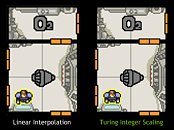- Joined
- Oct 9, 2007
- Messages
- 47,598 (7.45/day)
- Location
- Dublin, Ireland
| System Name | RBMK-1000 |
|---|---|
| Processor | AMD Ryzen 7 5700G |
| Motherboard | Gigabyte B550 AORUS Elite V2 |
| Cooling | DeepCool Gammax L240 V2 |
| Memory | 2x 16GB DDR4-3200 |
| Video Card(s) | Galax RTX 4070 Ti EX |
| Storage | Samsung 990 1TB |
| Display(s) | BenQ 1440p 60 Hz 27-inch |
| Case | Corsair Carbide 100R |
| Audio Device(s) | ASUS SupremeFX S1220A |
| Power Supply | Cooler Master MWE Gold 650W |
| Mouse | ASUS ROG Strix Impact |
| Keyboard | Gamdias Hermes E2 |
| Software | Windows 11 Pro |
NVIDIA, with its GeForce 436.02 Gamescom-special drivers. among several new features and performance updates, introduced integer scaling, a resolution upscaling algorithm that scales up extremely low-resolution visuals to a more eye-pleasing blocky pixellated lines by multiplying pixels in a "nearest-neighbor" pattern without changing their color, as opposed to bilinear upscaling, that blurs the image by attempting to add details where none exist, by altering colors of multiplied pixels.
Intel originally announced an integer upscaler this June that will be exclusive to the company's new Gen11 graphics architecture, since older generations of its iGPUs "lack the hardware requirements" to pull it off. Intel's driver updates that add integer-scaling are set to arrive toward the end of this month, and even when they do, only a tiny fraction of Intel hardware actually benefit from the feature (notebooks and tablets that use "Ice Lake" processors).

NVIDIA's integer upscaling feature has been added only to its "Turing" architecture GPUs (both RTX 20-series and GTX 16-series), but not on older generations. NVIDIA explains that this is thanks to a "hardware-accelerated programmable scaling filter" that was introduced with "Turing." Why this is a big deal? The gaming community has a newfound love for retro games from the 80's thru 90's, with the growing popularity of emulators and old games being played through DOSBox. Many small indie game studios are responding to this craze with hundreds of new titles taking a neo-retro pixellated aesthetic (eg: "Fez").
When scaled up to today's high-resolution displays, many of these games look washed out thanks to bilinear upscaling by Windows. This calls for something like integer upscaling. We're just surprised that NVIDIA and Intel aren't implementing integer upscaling on unsupported GPUs by leveraging programmable shaders. Shader-based upscaling technologies aren't new. The home-theater community is vastly invested in the development of MadVR, a custom-video renderer that packs several shader-based upscaling algorithms that only need Direct3D 9.0c-compliant programmable shaders.
Update 12:57 UTC: The NVIDIA 436.02 drivers have been released now and are available for download.
View at TechPowerUp Main Site
Intel originally announced an integer upscaler this June that will be exclusive to the company's new Gen11 graphics architecture, since older generations of its iGPUs "lack the hardware requirements" to pull it off. Intel's driver updates that add integer-scaling are set to arrive toward the end of this month, and even when they do, only a tiny fraction of Intel hardware actually benefit from the feature (notebooks and tablets that use "Ice Lake" processors).

NVIDIA's integer upscaling feature has been added only to its "Turing" architecture GPUs (both RTX 20-series and GTX 16-series), but not on older generations. NVIDIA explains that this is thanks to a "hardware-accelerated programmable scaling filter" that was introduced with "Turing." Why this is a big deal? The gaming community has a newfound love for retro games from the 80's thru 90's, with the growing popularity of emulators and old games being played through DOSBox. Many small indie game studios are responding to this craze with hundreds of new titles taking a neo-retro pixellated aesthetic (eg: "Fez").
When scaled up to today's high-resolution displays, many of these games look washed out thanks to bilinear upscaling by Windows. This calls for something like integer upscaling. We're just surprised that NVIDIA and Intel aren't implementing integer upscaling on unsupported GPUs by leveraging programmable shaders. Shader-based upscaling technologies aren't new. The home-theater community is vastly invested in the development of MadVR, a custom-video renderer that packs several shader-based upscaling algorithms that only need Direct3D 9.0c-compliant programmable shaders.
Update 12:57 UTC: The NVIDIA 436.02 drivers have been released now and are available for download.
View at TechPowerUp Main Site







